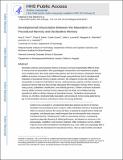Developmental dissociation between the maturation of procedural memory and declarative memory
Author(s)
Kalra, Priya B.; Sheridan, Margaret A.; Finn, Amy Sue; Goetz, Calvin; Leonard, Julia; Gabrieli, John D. E.; ... Show more Show less
DownloadGabrieli_Developmental dissociation.pdf (822.6Kb)
PUBLISHER_CC
Publisher with Creative Commons License
Creative Commons Attribution
Terms of use
Metadata
Show full item recordAbstract
Declarative memory and procedural memory are known to be two fundamentally different kinds of memory that are dissociable in their psychological characteristics and measurement (explicit vs. implicit) and in the neural systems that subserve each kind of memory. Declarative memory abilities are known to improve from childhood through young adulthood, but the developmental maturation of procedural memory is largely unknown. We compared 10-year-old children and young adults on measures of declarative memory and working memory capacity and on four measures of procedural memory that have been strongly dissociated from declarative memory (mirror tracing, rotary pursuit, probabilistic classification, and artificial grammar). Children had lesser declarative memory ability and lesser working memory capacity than adults, but children exhibited learning equivalent to adults on all four measures of procedural memory. Therefore, declarative memory and procedural memory are developmentally dissociable, with procedural memory being adult-like by age 10. years and declarative memory continuing to mature into young adulthood. Keywords: Development; Procedural memory; Declarative memory; Working memory; Skill learning; Learning; Memory
Date issued
2015-11Department
Massachusetts Institute of Technology. Department of Brain and Cognitive Sciences; McGovern Institute for Brain Research at MITJournal
Journal of Experimental Child Psychology
Publisher
Elsevier BV
Citation
Finn, Amy S. et al. “Developmental Dissociation Between the Maturation of Procedural Memory and Declarative Memory.” Journal of Experimental Child Psychology 142 (February 2016): 212–220 © 2015 Elsevier Inc
Version: Author's final manuscript
ISSN
0022-0965
1096-0457